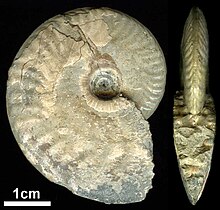
Amaltheus is an oxyconic ammonite with a fairly open umbilicus, serrated keel, and slightly sigmoidal ribs from the Lower Jurassic, many of which are strigate. Amaltheus, named by de Montfort, 1808, is indicative of the upper Pliensbachian stage in Europe, north Africa, Caucasus, Siberia, N. Alaska, Canada, Oregon, and possibly Honduras; and is the type for the Amaltheidae and a member of the Eoderoceratoidea.
Berniceras is an extinct ammonite genus from the order Ammonitida that lived during the early Oxfordian stage of the Late Jurassic. Berniceras is included in the ammonite family, Oppeliidae.
Bradfordia is a moderately involute to involute genus included in the ammonoid cephalopod family Oppeliidae, coiled so that the outer whorl encloses most, or much, of the previous, but with a small umbilicus exposing inner whorls. The shell is compressed, whorl height much greater than width, extending well out from the contact with the adjacent inner whorl. Outer flanks are finely ribbed and the rounded venter is smooth.
Praestrigites is a genus from the family Strigoceratidae which is included in the ammonitid superfamily Haploceratoidea.
Oecotraustes is an extinct cephalopod genus included in the ammonid family Oppeliidae and named by Waagen in 1869. The genus lived during the Middle Jurassic.
Lissoceras is an involute, smooth or finely vetrolaterally ribbed, ammonite with a blunt, un-keeled venter, included in the Haploceratidae, that lived from the Lower Bajocian - Middle Oxfordian in what is now Europe, south Asia, and southern Alaska.
Hebetoxyites is a genus of ammonoid cephalopod from the middle part of the Bajocian stage, middle Jurassic, included in the Strigoceratidae, Haploceratoidea. The shell is oxyconic, with a sharp rim but no keel, and involute, with the inner whorls hidden. The umbilicus is very small. Sides have a spiral ridge but are not striate.
Haploceratoidea, formerly Haplocerataceae, is an extinct superfamily of ammonoid cephalopods belonging to the Ammonitida that unites three families, Strigoceratidae, Oppeliidae, and Haploceratidae, listed below.
The Strigoceratidae is a family in the ammonitid superfamily Haploceratoidea, restricted to the lower Middle Jurassic, Bajocian stage, possibly derived from the Hammitoceratidae. The family was established and named by Buckman in 1924.

Hildoceratoidea, formerly Hildoceratacaea, is a superfamily of compressed or planulate ammonites, some tending to develop acute outer rims; generally with arcuate or sigmoidal ribs. Aptichus were found in place are double-valved.

Amaltheidae is a family of eoderoceratoidean ammonitids from the Lower Jurassic consisting of genera characterised by stigated discoidal oxycones—narrow involute shells with narrowly rounded to angular venters that bear a series of grooves, or ridges, along broad flanks, which according to the Treatise L, 1957, evolved into strongly ribbed planulates with quadrate whorls, typically with crenulated keels; involving all together four genera.

Perisphinctoidea, formerly Perisphinctaceae, is a superfamily of Middle Jurassic (Bajocian) to Lower Cretaceous (Barremian) ammonites, commonly with evolute shells with strong ribbing that typically divides about mid flank before crossing the venter.
The Haploceratidae is the type family of the Haploceratoidea, a superfamily in the ammonitina; which according to Donovan et al. (1981) can be derived from the Taramelliceratinae, a subfamily of the Oppeliidae.
Distichoceras is a member of the Haploceratacean family, Oppeliidae, and type genus for the subfamily Distichoceratinae, found in upper Middle and lower Upper Jurassic sediments in Europe, Algeria, India, and Madagascar. The shell is essentially evolute and compressed with the outer flanks converging on a narrow, keeled venter; inner flanks which may be feebly ribbed, are separated from outer by a shallow spiral groove or band. Ribs on outer flanks end on or are looped to tall clavi that line the venter, standing above the keel.

Hildoceratidae is a family of ammonoid cephalopods from the Lower Jurassic, lower Pliensbachian to lower Bajocian substages, generally with strongly ribbed, involute shells. They are combined with the Hammatoceratidae, Graphoceratidae, and Sonniniidae to make up the Hildoceratoidea.

Perisphinctidae is a family of Middle and Upper Jurassic discoidal ammonites in the order Ammonitida. They have a shell morphology that is mostly evolute, typically with biplicate, simple, or triplicate ribbing. Large forms have simple apertures and smooth body chambers while small forms have lappets and ribbed body chambers.
Oppeliinae is a subfamily within the Oppeliidae, a family of Jurassic ammonites characterized by forms that are mainly oxyconic, compressed with sharp venters, in the adult and with keeled inner whorls. Sutures are complex, consisting of a long series of evenly graded lobes and saddles with finely frilled endings.
Streblitinae is a subfamily of Upper Jurassic and Lower Cretaceous ammonites within the family Oppeliidae characterized by compressed, involute shells; typically oxycones with complex sutures. Includes Streblites, Pseudoppelia, and Substreblites. Derivation is from the Taramelliceratinae. May have given rise to the Aconiceratinade.
Mazapilitinae is a subfamily of Upper Jurassic ammonites included in the Oppeliidae. Shells are involute; venter rounded or gently tabulate; ribbing coarse, fold-like, branching.

Hammatoceratidae is a family of lower and middle Jurassic ammonites included in the superfamily Hildoceratoidea.






